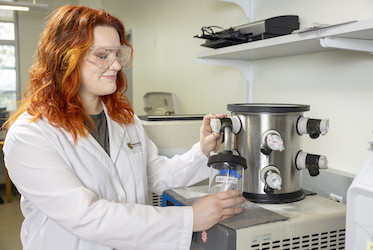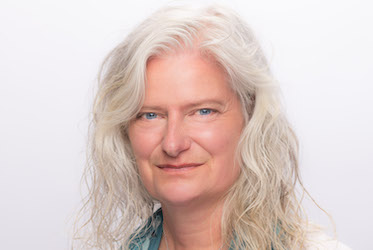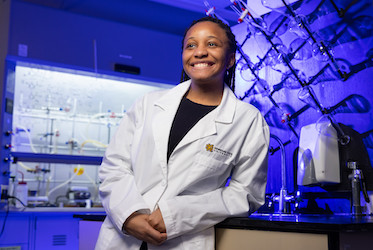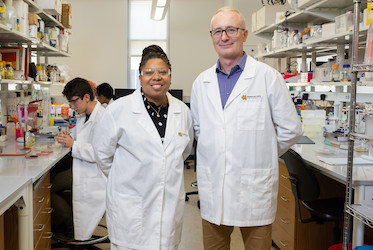
Kennesaw State professor’s work with insects draws attention
KENNESAW, Ga. | Oct 8, 2021

Early this year, Clint Penick’s voice floated over the airwaves on NPR and the BBC. His words appeared in scores of print and online media outlets, too.
The assistant professor of biology at Kennesaw State authored a paper on a new discovery about ants—that they can shrink and regrow their brains—which appeared in the prestigious scientific journal Proceedings of the Royal Society B. He found himself in virtual chats with print and broadcast journalists from around the world, explaining the ability of Indian jumping ants to regenerate brain tissue.
In addition to his appearances on the radio, stories on Penick’s research appeared in the New York Times, Smithsonian Magazine, National Geographic, and the Atlantic, among other periodicals.
It’s all in a day’s work for Penick, who arrived at KSU in 2019. For all his success as an evolutionary ecologist who specializes in studying social insects like ants and bees, he considers himself a storyteller who happens to have a background in science. He embraces fully the teaching component of his job whether it’s the readers of a nationally circulating magazine or students in his classes. With every opportunity, Penick draws on his love of explaining scientific discovery and making it relevant to wide audiences.
“I have been driven more by my interest in research than anything else, but what I’ve learned along the way is that the research projects that fascinate me the most are the ones that I can talk to other people about,” Penick says. “So science communication has been a huge part of my career. And that involves teaching.”
Researching Insect Societies
Penick’s research examines the success of social insects and the societies they form, divining what humans can learn from hundreds of millions of years of insect evolution. In his laboratory at Kennesaw State’s Department of Ecology, Evolution and Organismal Biology, Penick and his team focus on how social insects combat disease, deal with climate change, construct elaborate nests, and how they have become so dominant in our cities.
“Insects have learned to dominate our cities, partly because of their social nature. There's a huge benefit to being social, so we study the downstream effects of sociality and how it drives the ecological success of ants and bees,” he says. “Understanding how organisms evolved to cooperate and form societies is a major question in biology, and beyond insects, it digs into who we are as humans.”
One parallel between Penick’s work on social insects and humans’ own challenges as a social species is how they deal with disease. Living in dense groups increases the chance of disease transmission, so social organisms must develop public health strategies to fight disease. Penick points out that while humans have lived in groups for thousands of years, ants and bees have done so for hundreds of millions of years, which means they’ve had a lot more practice dealing with pathogens. One of Penick’s current studies focuses on how ants produce and use their own antibiotics—giving humans plenty of opportunities to learn from their six-legged friends.

Cultivating an Interest in Science
Originally a creative writing major at Florida State University, Penick added a biology major after taking a semester off to through-hike the two-thousand-mile-long Appalachian Trail. The walk revealed to him that he wanted a job that allowed him to be outside, and a major in biology allowed him to connect his interests in the outdoors with a career in research.
As an undergraduate at Florida State, Penick studied under professor Walter Tschinkel, one of the foremost experts on fire ants. Penick’s senior thesis focused on why fire ants build mounds—a surprisingly unusual trait among ants—and this inspired a lifelong fascination with ants and other insects. Tschinkel’s insistence on doing field work combined with an engaging teaching style further fired Penick’s desire to be a scientist.
“Scientific discoveries are something you learn about in the classroom, but you don’t get to make those discoveries yourself unless you get into a professor’s lab,” Penick says. “What was game-changing for me was having the opportunity to ask a question that no one had ever asked before and then develop a study to try and answer it. Once you pass the threshold from learning about science to actually doing science, you feel the excitement of stepping into the unknown. That is when my passion for research began.”
Penick graduated from Florida State in 2005 with dual degrees in biology and creative writing. He earned his Ph.D. at Arizona State in 2012, writing his dissertation on how ant queens develop. Most of his dissertation work took place in the lab, so he decided to look for a postdoctoral position that would get him back outside. This led him to a four-year stint as a postdoctoral researcher at North Carolina State in a lab that focused on how insects are impacted by climate change and urbanization. He then returned to Arizona State as the biologist-in-residence at the Biomimicry Center, an interdisciplinary research center that connected research in biology with emerging challenges in engineering and sustainability.
Still, Penick knew his best opportunity to engage the public and inspire the next generation of scientists would be as a professor. After two years at the Biomimicry Center, he joined Kennesaw State, bringing with him his compelling and relevant research and hundreds of thousands of dollars in funding.
On the Cutting Edge
Since arriving at KSU he has continued to research and publish prolifically, culminating in April with his paper in Proceedings of the Royal Society B. He has also taught introductory classes focused on evolution and ecology, which he says is the first place students catch the spark for biology.
Penick has also expanded his lab to include students with backgrounds in engineering and visual arts, which has led to design projects involving visual representations of various aspects of insects. One current project is funded by NASA—using the durable design of honeycomb to build stronger spacecraft.
This cutting-edge research takes place in and around KSU’s campus, with KSU students at the forefront. Penick admits he didn’t know much about Kennesaw State before he came to interview in 2019, but he sensed the buzz of a newly minted R2 institution, a group of young faculty members with similar ideas, and a growing campus rich with new perspectives.
“There's so much growth and new research taking off, and there are a lot of people who are also passionate about involving students in research,” he says. “Compared to other universities, there's just a lot of excitement at Kennesaw State.”
– Dave Shelles
Photos by Jason Getz
Related Stories
A leader in innovative teaching and learning, Kennesaw State University offers undergraduate, graduate and doctoral degrees to its more than 45,000 students. Kennesaw State is a member of the University System of Georgia with 11 academic colleges. The university’s vibrant campus culture, diverse population, strong global ties and entrepreneurial spirit draw students from throughout the country and the world. Kennesaw State is a Carnegie-designated doctoral research institution (R2), placing it among an elite group of only 7 percent of U.S. colleges and universities with an R1 or R2 status. For more information, visit kennesaw.edu.



















